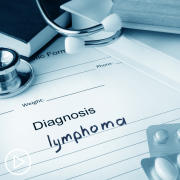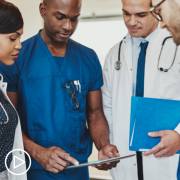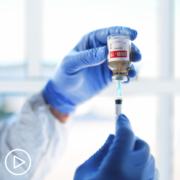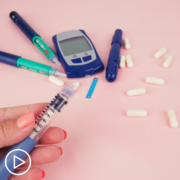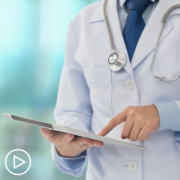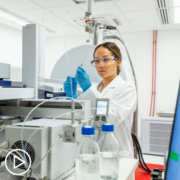An Overview of Current DLBCL Treatment Approaches
An Overview of Current DLBCL Treatment Approaches from Patient Empowerment Network on Vimeo.
What do diffuse large B-cell lymphoma (DLBCL) patients need to know about current treatment approaches? Expert Dr. Loretta Nastoupil provides an overview and gives an update about ongoing research comparing two treatment regimens.
Dr. Loretta Nastoupil is Director of the Lymphoma Outcomes Database in the Department of Lymphoma/Myeloma at The University of Texas MD Anderson Cancer Center. Learn more about Dr. Nastoupil, here.
See More From The Pro-Active DLBCL Patient Toolkit
Related Programs:

|

Diffuse Large B-Cell Lymphoma (DLBCL) Treatment and Research News |

How Is Diffuse Large B-Cell Lymphoma (DLBCL) Treated? |
Transcript:
Katherine:
Dr. Nastoupil, now that we’ve discussed factors that go into the treatment choices, can you walk us through the currently available DLBCL treatment approaches and who they might be right for?
Dr. Nastoupil:
Absolutely. So, again, this is changing, and that’s good news. So, up until recently, R-CHOP or rituximab in combination with CHOP, which is an acronym for four different drugs, cyclophosphamide, doxorubicin, vincristine, and prednisone, has been our standard.
Again, what would potentially challenge that is the POLARIX study where we exchange vincristine for polatuzumab. We don’t know the results of that study yet. All we know is that it met its primary endpoint, meaning it met what it set out to do in terms of improving upon some of the outcomes achieved with R-CHOP.
We need to see the details to know if that means now every newly diagnosed diffuse large B-cell lymphoma patient will be offered the polatuzumab in combination with R-CHP study or whether or not there will still be some patients appropriate for R-CHOP.
But that is generally our first approach. Whether you get six cycles or a shortened course plus/minus radiation depends on your state. Once patients have completed therapy, generally, then we pursue what’s called surveillance.
So, we’re monitoring for any signs that the lymphoma has recurred or has not gone away. That’s a controversial topic in terms of how to conduct surveillance and one that I suspect will change over time. But for most patients, if the lymphoma is going to recur, it generally recurs within the first two years.
So, assessing patients either in the form of a CT scan, a PET CT, or a physical exam with labs every four to six months for the first two years is what most practices will pursue. I’m not saying that there is no chance that you would relapse beyond two years. It’s just that the majority of patients, at least 90 percent, if the lymphoma comes back, it usually does so within two years.
And the relapses that occur beyond two years are less predictable. They could happen at three years. They could happen at 10 years, as it’s hard to know how to do surveillance beyond two years.
If the lymphoma recurs, the first thing we need to do is biopsy it because there are many things that can mimic lymphoma on a scan – infection, inflammation, other tumor types. So, if there is ever a question about whether or not the lymphoma has recurred, I generally advise for all patients they undergo a biopsy to ensure that we know what we’re treating.
Depending on when the lymphoma recurs, if it happens within 12 months, this is another area that we are shifting our practice. In the past, for all patients who had relapsed large cell lymphoma, we would pursue what we call salvage or second-line chemotherapy. So, we mix up the chemo. We keep, generally, the rituximab, but we alter the chemotherapy agents. We wouldn’t give CHOP again.
And then we give a shortened course where we give two to three cycles. We repeat the scan. And for patients who’ve achieved what we call chemo-sensitive disease – so, that’s generally a complete response on scan – we would then move forward with high-dose therapy and an autologous stem cell transplant. So, essentially giving different but more intense chemo and rescuing patients from that maneuver with their own stem cells that will go back to the bone marrow and start making white blood cells, red cells, and platelets again.
What has shifted in the last six months is we now know that CAR T-cell therapy is superior to that approach, at least with two CAR Ts for patients whose lymphoma came back within 12 months. Again, we’re eagerly awaiting the full results of those randomized studies. But three trials were conducted. Two of the three suggest CAR T is better than second chemo and transplant for those patients who relapse within 12 months.
So, currently, we think that you’ll have a CHOP-like therapy with plus rituximab frontline. If you progress within 12 months, you potentially would be a candidate for CAR T-cell therapy. If the CAR T-cell therapy fails, which is true for about half of patients. Or if you’re deemed to not be a candidate for CAR T, we have several other new options that didn’t exist a year ago, including targeted or non-chemotherapy options.
So, there are at least four options in that setting now that are therapies that target the lymphoma cells, either by targeting CD19, which is another surface marker, augmenting that either with an antibody drug conjugate, such as loncastuximab tesirine (Lonca), or with an immune therapy, such as lenalidomide (Revlimid) and tafasitamab. Polatuzumab (Polivy) is available in that third line or later space combined with bendamustine (Treanda) and rituximab (Rituxan). There’s an oral agent called Selinexor (Xpovio).
So, a lot of that is not to burden patients with information but to let them know they’ve got lots of options. And many of these can be sequenced. So, if we can’t achieve cure with R-CHOP and/or CAR T, there are still very good outcomes in that third line or later space.

